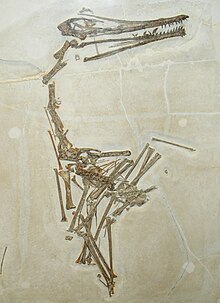Ardeadactylus
|
Ardeadactylus Temporal range: Late Jurassic, 152 Ma |
|
|---|---|
 |
|
| SMNS 56603, the neotype | |
| Scientific classification | |
| Kingdom: | Animalia |
| Phylum: | Chordata |
| Class: | Reptilia |
| Order: | †Pterosauria |
| Suborder: | †Pterodactyloidea |
| Genus: |
†Ardeadactylus Bennett, 2013 |
| Species: | †A. longicollum |
| Binomial name | |
|
Ardeadactylus longicollum (von Meyer, 1854) |
|
| Synonyms | |
|
|
Ardeadactylus (from Ardea – meaning "heron", and also a name of a genus of herons – and dactylus, meaning "finger") is an extinct genus of pterodactylid archaeopterodactyloid pterosaur known from the Late Jurassic Solnhofen limestone of Bavaria, southern Germany. It contains a single species, Ardeadactylus longicollum, which was originally thought to be a species of Pterodactylus.
Only two specimens of Ardeadactylus are known to exist currently: SMNS 56603 (earlier SMNS 5802) found in 1874, a specimen from Nusplingen initially thought to belong to the species Pterodactylus suevicus Quenstedt (currently Cycnorhamphus) and the neotype of the species, and JME-SOS 2428, a specimen held at Jura Museum in Eichstätt. Other known specimens, including the holotype designated by Christian Erich Hermann von Meyer when he named the type species Pterodactylus longicollum in 1854, were lost during World War II. The original holotype, consisting of the skull, neck and anterior torso, had been found near Eichstätt in 1853 and was that year acquired for the Herzoglich Leuchtenbergische Naturalien-Kabinett by Professor Ludwig Frischmann. Its destruction motivated Peter Wellnhofer to assign a neotype in 1970.
...
Wikipedia
